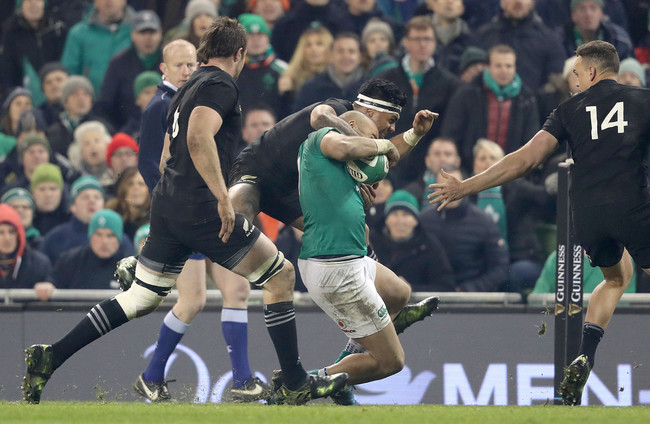RUGBY TRIALS AIMING to reduce the risk of head injury by lowering the height of tackles will continue over the upcoming season, with the new Championship Cup in England set to be the latest testing ground.
The trial in the Championship Cup will see the law around dangerous tackles changed for the 2018/19 season, “altering the definition of a high tackle from above the line of the shoulders to above the armpit line.”
The Championship Cup is a new RFU-run competition involving the 12 clubs from the Championship, England’s professional second-tier league.
The RFU says the trial will look to “assess the impact of introducing a lower tackle height in elite adult rugby on the incidence of concussion and other injuries, player behaviour in the tackle, the nature of tackles, head injury events and other game events.”
The data gathered from analysis of this trial by the RFU will be shared with World Rugby, which has recently undertaken and announced similar trials in some of its own global competitions.
The World Rugby U20 Championship in France in June saw an increased focus on cutting high tackles out of the game, with any tackles that increased the risk of head injury being cited.
Match citing commissioners also issued ‘high tackle warnings’ to any players who were deemed to have been “upright [not bent at the waist]” in the tackle.
Tacklers were deemed upright when they were “in an approximate upright standing position,” had “made no clear attempt to lower the height of contact with the ball carrier to avoid the head or shoulders of the ball carrier,” and showed “no knee flexion and minimal bending at the waist [bringing] the head into a dangerous position for collision with ball carrier’s head or shoulder.”
High tackle warnings were issued for all high-contact penalties in games, all tackles that resulted in a Head Injury Assessment [HIA], high tackles missed during games, as well as any accidental clear and obvious head-to-head and head-to-shoulder contact.
Each high tackle warning counted as ‘one strike,’ with two strikes meaning that a player was suspended for one game.
World Rugby also announced in May that this year’s World Rugby U20 Trophy will see see a trial that involves lowering the acceptable height of a tackle to “below the nipple line.”
The U20 Trophy takes place in Romania from 24 August to 10 September and involves nations such as Fiji, Portugal, Samoa and Canada.
That trial will see Law 9.13 of World Rugby’s law book amended to read as follows:
“A player must not tackle an opponent early, late or dangerously. Dangerous tackling includes, but is not limited to, tackling or attempting to tackle an opponent above the nipple line even if the tackle starts below the nipple line.”
All of these trials come after extensive research by World Rugby determined that tacklers who are upright carry the greatest risk of head injury.
World Rugby studied 1,500 top-level games and said its analysis showed that 76% of head injuries occur in the tackle, while 72% of head injuries in the tackle occur to the tackler.
World Rugby also said that its data showed that “the risk of injury to both players from a high-contact tackle [when the tackler is upright] is 4.3 times greater than a low-contact tackle.”
Furthermore, World Rugby said that “head-on-head contact [when the tackler is upright] is 6.5 times more likely to result in a head injury than the lower head-to-hip tackle.”
The42 is on Instagram! Tap the button below on your phone to follow us!












Will anything be done about how a player enters the tackle as an attacker? Lowering shoulders for the contact and especially within the five yard line, diving for the try line. How can a player the ball carrier in these instances?
Not picking on small players but when they try duck out of a tackle from a bigger player is that not also creating a dangerous situation? The bigger player might be doing everything right but still get penalised for a high contact.
@Tony Walsh: *how can a player tackle the ball carrier*
@Tony Walsh: I think in terms of a small fella ducking under a bigger lad common sense would have to take place. It’s all down to severity of the outcome and again one man’s interpretation.
@Tony Walsh: Players will go in low to attract penalties, while it is a law worth looking at there will always be unintended consequences with laws and this could be one of them.
@Tony Walsh: The onus is on the tackler to tackle legally, it’s not really the small or ducking players problem if that inconveniences someone swinging their arm at chest height. They’re not “doing everything right” if they failed to adjust their tackle in time for a movement anyway so it would be the tackler creating the danger in that scenario.
I think that gives an advantage to the attacking player, you’ll end up on your arse trying to get into position or your body shape will give away what side you’re leaning to and a fella with quick feet will skip past. Maybe it’ll work , who knows I suppose it really depends on the refs interpretation of crouching and if he’s a good judge of spotting nipples through shirts.
Should benefit rugby league style high offloaders (SBW, Nakwrawa) and short steppers (Larmour, Earls).
72% of injuries in the tackle are to the *tackler* so stopping him hitting someone above the nipple is going to do …..what ….exactly?